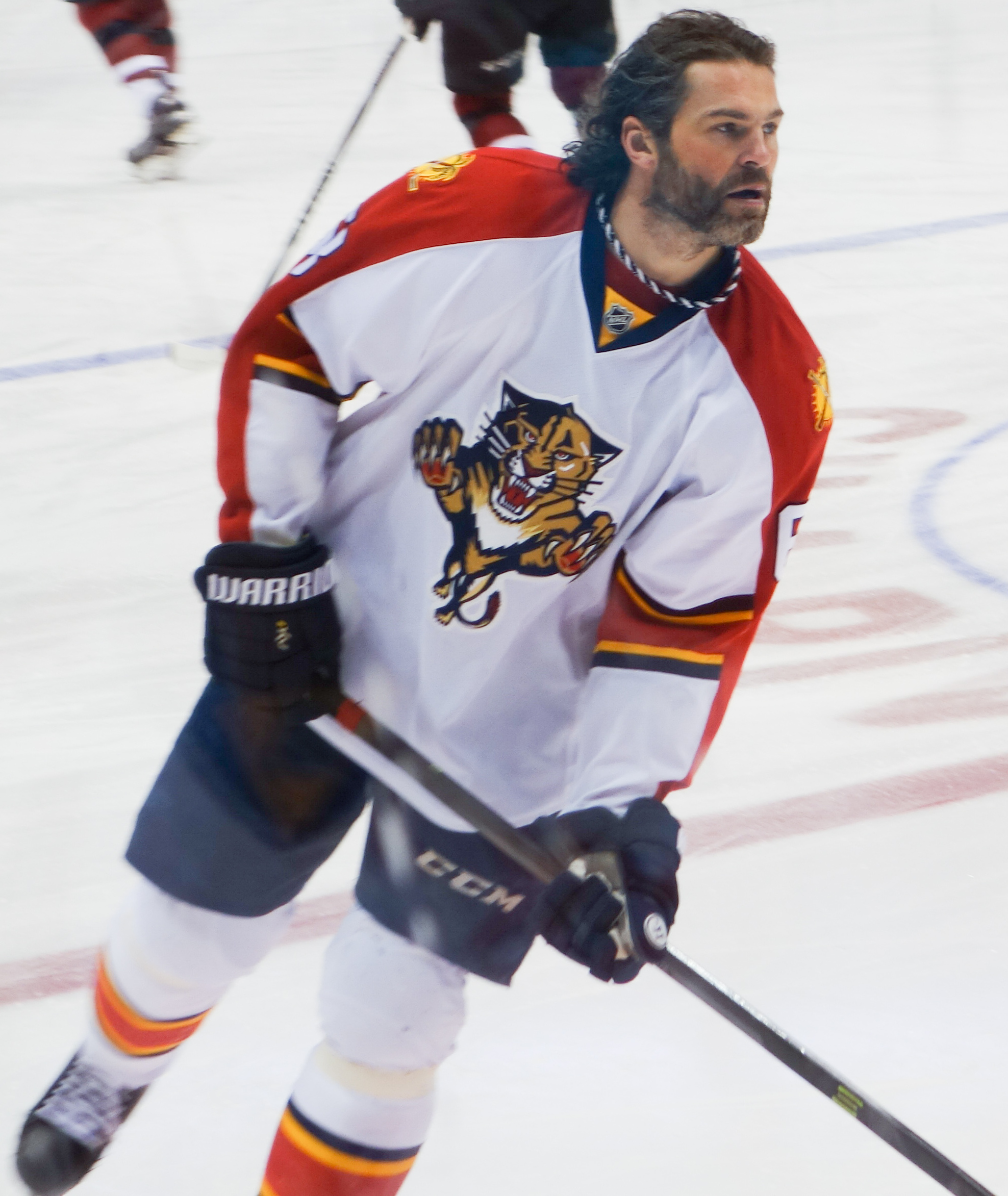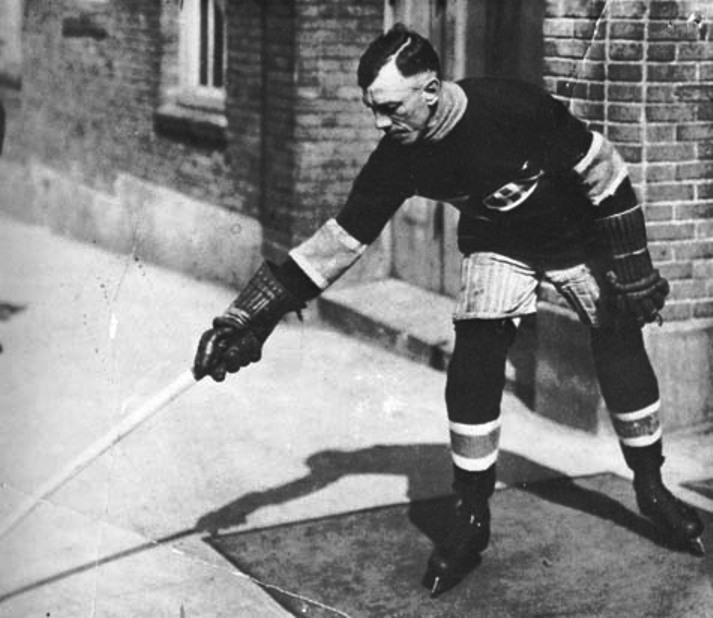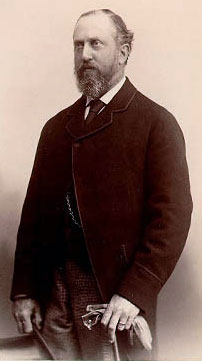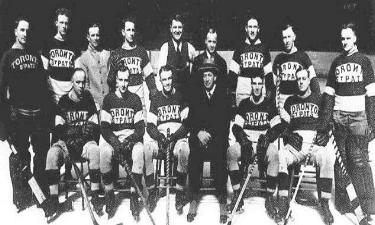|
Charles Tobin
Charles Stuart Tobin (November 24, 1885 – May 30, 1924) was a Canadian professional ice hockey player. Tobin played 175 games in various professional and amateur leagues, including the Pacific Coast Hockey Association (PCHA). Amongst the PCHA teams he played for were the New Westminster Royals, Portland Rosebuds, Seattle Metropolitans, Vancouver Millionaires and Victoria Cougars. Personal life Tobin was born in Winnipeg, Manitoba. He died in 1924 at St. Vincent's Hospital in Portland, Oregon after illness due to ulcers of the stomach. Playing career Tobin first played senior-level ice hockey with the Edmonton Thistles in 1904–05. Starting in 1906, Tobin played for several teams in early western Canada professional leagues, such as Battleford of the Alberta Professional League, Winnipeg Monarchs, Winnipeg Shamrocks and Winnipeg Hockey Club of the Manitoba leagues, Prince Albert, Saskatoon and Moose Jaw of the Saskatchewan Professional League. Hockey on the Canadian Prairies ... [...More Info...] [...Related Items...] OR: [Wikipedia] [Google] [Baidu] |
Winger (ice Hockey)
Winger, in the game of ice hockey, is a forward position of a player whose primary zone of play is along the outer playing areas. They typically flank the centre forward. Originally the name was given to forward players who went up and down the sides of the rink. Wingers generally have the least defensive responsibilities out of any position on the ice, however they are still tasked with defensive duties such as forechecking duties or covering the point in the defensive zone. Nowadays, there are different types of wingers in the game — out-and-out goal scorers, checkers who disrupt the opponents, and forwards who work along the boards and in the corners. Often a winger's precise role on a line depends upon what type of role the other winger plays; usually lines will have one more goal-scoring oriented winger and one winger more focused on playing the boards, checking and passing the puck to others to take shots (if a larger player, he will sometimes be called a "power forward ... [...More Info...] [...Related Items...] OR: [Wikipedia] [Google] [Baidu] |
Joe Hall (ice Hockey)
Joseph Henry "Bad Joe" Hall (May 3, 1881 – April 5, 1919) was a Canadian professional ice hockey player. Known for his aggressive playing style, Hall played senior and professional hockey from 1902 to 1919, when he died as a result of the Spanish flu pandemic. He won the Stanley Cup twice with the Quebec Bulldogs and once with the Kenora Thistles, and became hospitalized while participating in the 1919 Stanley Cup Finals, which were cancelled four days before he died. Career Hall was born in Milwich_in_Staffordshire.html" ;"title="S Explorer Map 258: Stoke-on-Trent & Newcastle-under-Lyme: (1:25 000) : S Explorer Map 258: Stoke-on-Trent & Newcastle-under-Lyme: (1:25 000) : [...More Info...] [...Related Items...] OR: [Wikipedia] [Google] [Baidu] |
1913–14 PCHA Season
The 1913–14 PCHA season was the third season of the professional men's ice hockey Pacific Coast Hockey Association league. Season play ran from December 5, 1913, until February 24, 1914. Like the previous two seasons, teams were to play a 16-game schedule, but one game was cancelled. The Victoria Aristocrats club would be the PCHA champions. After the season, Victoria travelled to Toronto to play the Toronto Hockey Club, National Hockey Association (NHA) champions, in a challenge series for the 1914 Stanley Cup. Toronto won the series. League business Frank Patrick became league president, succeeding C. E. Doherty. The Victoria Senators changed their name to the Victoria Aristocrats. In the fall of 1913, the PCHA and the NHA agreed to support a draft arrangement, whereby the PCHA could draft NHA players annually for four years. The PCHA would draft three players on a rotating basis among the NHA teams. The first draft, in 1914, would have the PCHA select one player from Ottawa, ... [...More Info...] [...Related Items...] OR: [Wikipedia] [Google] [Baidu] |
Stanley Cup
The Stanley Cup (french: La Coupe Stanley) is the championship trophy awarded annually to the National Hockey League (NHL) playoff champion. It is the oldest existing trophy to be awarded to a professional sports franchise in North America, and the International Ice Hockey Federation (IIHF) considers it to be one of the "most important championships available to the sport". The trophy was commissioned in 1892 as the Dominion Hockey Challenge Cup and is named after Lord Stanley of Preston, the Governor General of Canada, who donated it as an award to Canada's top-ranking amateur ice hockey club. The entire Stanley family supported the sport, the sons and daughters all playing and promoting the game. The first Cup was awarded in 1893 to Montreal Hockey Club, and winners from 1893 to 1914 were determined by challenge games and league play. Professional teams first became eligible to challenge for the Stanley Cup in 1906. In 1915, the National Hockey Association (NHA) and the Pacifi ... [...More Info...] [...Related Items...] OR: [Wikipedia] [Google] [Baidu] |
Manitoba Hockey Association
The Manitoba Hockey Association (MHA) was an early men's senior ice hockey league playing around 1900 in Manitoba, Canada. The league started as an elite amateur league in 1892, became professional in 1905, had a professional and an amateur league in 1908–09 and only an amateur league from 1909 until 1923. Two teams from the league won the Stanley Cup, the Winnipeg Victorias and the Kenora Thistles. Three other teams from the league challenged for the Stanley Cup: Brandon Wheat City Hockey Club, Brandon Wheat City, Winnipeg Maple Leafs, and the Winnipeg Rowing Club. Other teams in the league won the Allan Cup: Winnipeg Hockey Club, Winnipeg Falcons, Winnipeg Monarchs (senior), Winnipeg Monarchs and Winnipeg Victorias. It also was known as the Manitoba Hockey League and Manitoba Professional Hockey League in following years. History Founding The Manitoba Hockey Association was formed on November 11, 1892 to organize ice hockey play in Manitoba. Manitoba & Northwestern Hocke ... [...More Info...] [...Related Items...] OR: [Wikipedia] [Google] [Baidu] |
Penalty (ice Hockey)
A penalty in ice hockey is a punishment for an infringement of the rules. Most penalties are enforced by sending the offending player to a penalty box for a set number of minutes. During the penalty the player may not participate in play. Penalties are called and enforced by the referee, or in some cases, the linesman. The offending team may not replace the player on the ice (although there are some exceptions, such as fighting), leaving them short-handed as opposed to full strength. When the opposing team is said to be on a ''power play'', they will have one more player on the ice than the short-handed team. The short-handed team is said to be "on the penalty kill" until the penalty expires and the penalized player returns to play. While standards vary somewhat between leagues, most leagues recognize several common varieties of penalties, as well as common infractions. The statistic used to track penalties is called "penalty minutes" and abbreviated to "PIM" (spoken as single w ... [...More Info...] [...Related Items...] OR: [Wikipedia] [Google] [Baidu] |
Point (ice Hockey)
In ice hockey, point has three contemporary meanings. Personal stat A point is awarded to a player for each goal scored or assist earned. The total number of goals plus assists equals total points. The Art Ross Trophy is awarded to the National Hockey League (NHL) player who leads the league in scoring points at the end of the regular season. Team stat Points are also awarded to assess standings (or rankings). Historically, teams were awarded two points for each win, one point for each tie and no points for a loss. Such a ranking system, implemented primarily to ensure a tie counted as a "half-win" for each team in the standings, is generally regarded as British and/or European in origin and as such adopted by the National Hockey League which was founded in Canada where leagues generally used ranking systems of British origin. Awarding points in the standings contrasts with traditional American ranking systems favored in sports originating within the United States where today the m ... [...More Info...] [...Related Items...] OR: [Wikipedia] [Google] [Baidu] |
Assist (ice Hockey)
In ice hockey, an assist is attributed to up to two players of the scoring team who shot, passed or deflected the puck towards the scoring teammate, or touched it in any other way which enabled the goal, meaning that they were "assisting" in the goal. There can be a maximum of two assists per goal. The assists will be awarded in the order of play, with the last player to pass the puck to the goal scorer getting the primary assist and the player who passed it to the primary assister getting the secondary assist. Players who gain an assist will get one point added to their player statistics. Despite the use of the terms "primary assist" and "secondary assist", neither is worth more than the other, and neither is worth more or less than a goal. Assists and goals are added together on a player's scoresheet to display that player's total points. Special cases If a player scores off a rebound given up by a goaltender, assists are still awarded, as long as there is no re-possession by t ... [...More Info...] [...Related Items...] OR: [Wikipedia] [Google] [Baidu] |
Goal (ice Hockey)
In ice hockey, a goal is scored when the puck entirely crosses the goal line between the two goal posts and below the goal crossbar. A goal awards one point to the team attacking the goal scored upon, regardless of which team the player who actually deflected the puck into the goal belongs to (see also own goal). Typically, a player on the team attempting to score shoots the puck with their stick towards the goal net opening, and a player on the opposing team called a goaltender tries to block the shot to prevent a goal from being scored against their team. The term goal may also refer to the structure in which goals are scored. The ice hockey goal is rectangular in shape; the front frame of the goal is made of steel tube painted red (blue in the ECHL because of a sponsorship deal with GEICO) and consists of two vertical goalposts and a horizontal crossbar. A net is attached to the back of the frame to catch pucks that enter the goal and also to prevent pucks from entering it ... [...More Info...] [...Related Items...] OR: [Wikipedia] [Google] [Baidu] |
Season (sports)
In an organized sports league, a typical season is the portion of one year in which regulated games of the sport are in session: for example, in Major League Baseball the season lasts approximately from the last week of March to the last week of September. In other team sports, like association football or basketball, it is generally from August or September to May although in some countries - such as Northern Europe or East Asia - the season starts in the spring and finishes in autumn, mainly due to weather conditions encountered during the winter. A year can often be broken up into several distinct sections (sometimes themselves called seasons). These are: a preseason, a series of exhibition games played for training purposes; a regular season, the main period of the league's competition; the postseason, a playoff tournament played against the league's top teams to determine the league's champion; and the offseason, the time when there is no official competition. Preseason In ... [...More Info...] [...Related Items...] OR: [Wikipedia] [Google] [Baidu] |
1922 Stanley Cup Finals
The 1922 Stanley Cup Finals was contested by the National Hockey League (NHL) champion Toronto St. Patricks and the Pacific Coast Hockey Association (PCHA) champion Vancouver Millionaires. The St. Pats defeated Vancouver three games to two in the best-of-five game series to win their only Stanley Cup as the St. Pats.Predecessor club 'Torontos' and descendent club 'Toronto Maple Leafs' would win Stanley Cups. This was the last Stanley Cup Finals contested by a team from Vancouver until the 1982 Stanley Cup Finals. All games were held at Arena Gardens in Toronto. Paths to the Finals Vancouver finished second overall in the 1921–22 PCHA regular season standings with a 12–12 record. However, they then went on to defeat the 12–11–1 first place Seattle Metropolitans in the PCHA championship series, winning both games by 1–0. Meanwhile, the 1921–22 NHL season was capped with the 13–10–1 second place St. Patricks defeating the 14–8–2 first place Ottawa Senators, 5� ... [...More Info...] [...Related Items...] OR: [Wikipedia] [Google] [Baidu] |
1920 Stanley Cup Finals
The 1920 Stanley Cup Finals was contested by the National Hockey League (NHL) champion Ottawa Senators and the Pacific Coast Hockey Association (PCHA) champion Seattle Metropolitans. The Senators won the series by three games to two in the best-of-five game series. Although all of the games for the series were scheduled to be played at The Arena in Ottawa, unseasonably warm weather and poor ice conditions forced the last two contests to be played on the artificial ice at Toronto's Arena Gardens. This would be the last Stanley Cup Finals appearance for a team based on the West Coast of the United States until the 1993 Stanley Cup Finals. It is the last Finals appearance by a Seattle-based team to date. Paths to the Finals The Senators captured the 1919–20 NHL title after they won both halves of the regular season, thus eliminating the need for a league championship playoff. Meanwhile, Seattle finished the 1919–20 PCHA regular season in first place with a 12–10 record, but ... [...More Info...] [...Related Items...] OR: [Wikipedia] [Google] [Baidu] |









